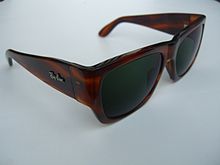Bausch & Lomb
| Bausch & Lomb
|
|
|---|---|
| legal form | Incorporated |
| founding | 1853 |
| Seat |
Rochester , New York , United States |
| Number of employees | 12,400 (as of 2005) |
| sales | $ 2.232 billion (as of 2005) |
| Branch | optics |
| Website | www.bausch.com |
Founded in the USA in 1853 , Bausch & Lomb is an international manufacturer of contact lenses and other medical technology products ( drugs , implants for eye diseases). Bausch & Lomb also became known through the famous Ray-Ban eyewear brand , which was sold to the Italian Luxottica Group in 1999 .
Company history
Founding years and early expansion
Bausch & Lomb was founded in Rochester, New York , in 1853 by two German immigrants , Johann Jakob Bausch and Henry C. Lomb . Jacob Bausch was a trained optician and found in Henry Lomb a financier and partner for a manufacture of monocles . The breakthrough came with the business partners in 1861 with the production of monocles with rubber frames, which were very popular at the time. In the second generation, production was expanded to include microscopes from 1875 and, in cooperation with the Zeiss works in Germany, to optical lenses in 1892 . In addition to glasses , microscopes and binoculars , the product range at the end of the 19th century also included projectors , camera lenses and apertures.
Production expansion at the beginning of the 20th century
With the expansion of the US armed forces under President Theodore Roosevelt and the establishment of the " Great White Fleet ", Bausch & Lomb received the order for the manufacture of high-precision lenses for optical measurements through the supplier Saegmuller and founded a joint venture with Saegmuller . At the same time, a research department with five employees was set up. In addition, a renewed alliance with the Zeiss works in Germany secured the three companies involved, Bausch & Lomb, Saegmuller and Zeiss, competitive advantages through the use of patents and market developments. In 1902, William Bausch, the son of the company founder, developed a method to cast molten glass directly into the desired lens shape using a casting process. Since the pieces of glass for the lenses had to be separated from chunks of glass beforehand and ground in a complex process, this resulted in enormous savings in time and material.
First and Second World War
Due to the world wars and the associated greater demand for optical measuring devices such as binoculars , target finders , camera lenses and periscopes , the production range could be expanded. At that time, the share of military products was 70 percent of total production. One of the most famous developments of this time is the Ray-Ban brand sunglasses, developed in 1926 for pilots.
Time after 1945
After the Second World War, the field of photography and ophthalmic optics was brought back to the fore and production was partially converted. Production sites were also established in Canada , Brazil and Argentina .
While the cinema was being displaced more and more by the television, Bausch & Lomb succeeded in developing the CinemaScope lens, which enabled the " widescreen " effect, with which the picture width in cinemas was doubled and the popularity of the cinema increased again. 1971, Bausch & Lomb, the first contact lenses from polyHEMA on the market. In contrast to the previously available contact lenses made of glass and polymethyl methacrylate ( Lucite ), these lenses were softer and more comfortable to wear. In the mid-1980s, the former core areas of optical lens manufacture were sold. The division for sunglasses was continued, as these continued to find large sales. Through acquisitions of the Polymer Technology Corporation and the Dr. Mann Pharma was able to strengthen existing business areas, but also to develop new ones. In 1997, in the course of a series of company acquisitions, the area of manufacturing surgical products was finally established.
Company development in the recent past
Bausch & Lomb has meanwhile developed into a globally operating company. The headquarters are still in Rochester. Today around 12,000 employees work for the company in 36 countries. Total sales for 2005 were $ 2.2 billion. The healthcare provider’s competitors in the international market are Johnson & Johnson , Alcon , Allergan , MSD Chibret and Ciba Vision . In May 2013, Bausch & Lomb was sold to Valeant by the previous owner Warburg Pincus .
Business areas
The business areas are divided into three major areas:
- Vision Care: contact lenses and care products. Although a number of new business areas in the area of "Vision Care" have developed in the course of product diversification in recent years, the manufacture of contact lenses with a sales share of 28 percent in 2001 is still part of the core business.
- Pharmaceuticals: Medicines for various eye diseases and irritations. In this division, pharmaceutical products for the eye are manufactured with a turnover share of 21 percent.
- The “Surgicals” division is divided into “Refractive Surgery” with 8 percent and “Cataract and Vitreotinal Surgery” with 18 percent of sales. "Refractive Surgery" mainly comprises medical analyzers and lasers that are needed for eye operations. In order to strengthen this area, the competing market leaders Storz and Chiron were taken over in 1998.
Individual evidence
- ↑ Pharmaceutical company Valeant grabs Bausch & Lomb. Article in Manager Magazin online , May 27, 2013.
- ↑ Bausch & Lomb sold for $ 8.7 billion. Article on the ORF website , May 27, 2013.
